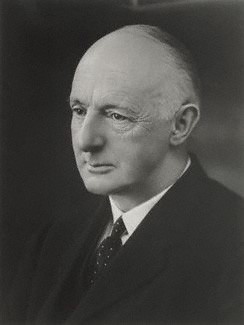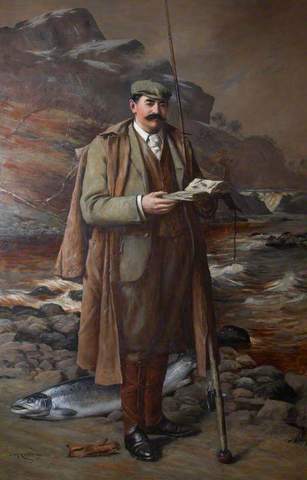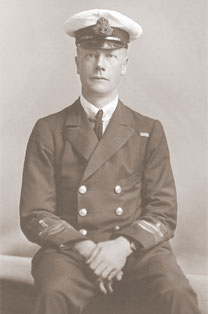
Sir Edwin Landseer Lutyens was an English architect known for imaginatively adapting traditional architectural styles to the requirements of his era. He designed many English country houses, war memorials and public buildings. In his biography, the writer Christopher Hussey wrote, "In his lifetime (Lutyens) was widely held to be our greatest architect since Wren if not, as many maintained, his superior". The architectural historian Gavin Stamp described him as "surely the greatest British architect of the twentieth century".

Castle Drogo is a country house and mixed-revivalist castle near Drewsteignton, Devon, England. Constructed between 1911 and 1930, it was the last castle to be built in England. The client was Julius Drewe, the hugely successful founder of the Home and Colonial Stores. Drewe chose the site in the belief that it formed part of the lands of his supposed medieval ancestor, Drogo de Teigne. The architect he chose to realise his dream was Edwin Lutyens, then at the height of his career. Lutyens lamented Drewe's determination to have a castle but nevertheless produced one of his finest buildings. The architectural critic Christopher Hussey described the result: "The ultimate justification of Drogo is that it does not pretend to be a castle. It is a castle, as a castle is built, of granite, on a mountain, in the twentieth century".

Sir Āpirana Turupa Ngata was a prominent New Zealand statesman. He has often been described as the foremost Māori politician to have served in parliament in the mid-20th century, and is also known for his work in promoting and protecting Māori culture and language. His legacy is one of the most prominent of any New Zealand leader in the 20th century, and is commemorated by his depiction on the fifty dollar note.

Sulhamstead is a village and civil parish in West Berkshire, England. It occupies an approximate rectangle of land south of the (Old) Bath Road (A4) between Reading, its nearest town and Thatcham. It has several small clusters of homes and woodland covering about a fifth of the land, in the centre and north beside which is Thames Valley Police's main Training Centre at Sulhamstead House. Its main amenities are its Church of England parish church and a shop and visitor centre by the Kennet & Avon Canal.

Nyahururu is a town in Kenya, lying north east of Nakuru. The town derives its name from the Maasai word e-naiwurruwurr, meaning waterfall and/or windy or place of storms. It is allegedly located in Laikipia County. Despite this, Nyahururu formerly functioned as the administrative capital of Nyandarua District, before it became a county, until the headquarters was shifted to Ol Kalou. There have been calls for a reversal. The town has an urban population of 36,450. The town still continues to be a central economic power of the immediate former district of Nyandarua. For that reason, the town has strong economic ties to the two counties.
Njoro is an agricultural town 18 km west south west of Nakuru, Kenya situated on the western rim of the Rift Valley. Njoro town was the headquarters of the former Njoro District, hived off Nakuru District. It was declared as one of the constituencies of Nakuru County in 2010. It has a population of 238,773 people according to the 2019 census report that was published by the Kenya National Bureau of Statistics (KNBS).
Egerton University is a public university in Kenya. It is the oldest institution of higher education in Kenya.
Thomas Patrick Gilbert Cholmondeley was a Kenyan farmer. He was the great-grandson of the 3rd Baron Delamere, one of the first and most influential British settlers in Kenya, and was heir to the Delamere title at the time of his death, being the eldest son of the 5th Baron Delamere.
Colin Robert Vaughan Campbell, 7th Earl Cawdor, DL is a Scottish peer, landowner, and architect.

Hugh Cholmondeley, 3rd Baron Delamere,, styled The Honourable from birth until 1887, was a British peer. He was one of the first and most influential British settlers in Kenya.

Lake Elmenteita is a soda lake, in the Great Rift Valley, about 120 km northwest of Nairobi, Kenya.
Galbraith Lowry Egerton Cole (1881–1929) was an Anglo-Irish pioneer settler and farmer (1905) of the East Africa Protectorate. Part of his Kekopey Ranch on Lake Elementaita, Kenya, where he is buried, is preserved today as the Lake Elementaita Lodge.

Commander Alexander George Francis Drogo Montagu, 10th Duke of Manchester, OBE, RN was a Royal Navy officer and British hereditary peer. From birth until February 1947, he was known by the courtesy title of Viscount Mandeville.

Julius Charles Drewe was an English businessman, retailer and entrepreneur who founded Home and Colonial Stores, and who ordered the building of Castle Drogo in Devon.

The House of Montagu, also known throughout history as Montagud, Montaigu, Montague, Montacute, is an English noble family founded in Somerset after the Norman Conquest of 1066 by the Norman warrior Drogo de Montagud. They rose to their highest power and prominence in the 14th and 15th centuries as Earls of Salisbury, the last in the male line being Thomas Montagu, 4th Earl of Salisbury (1388–1428), the maternal grandfather of "Warwick the Kingmaker", 16th Earl of Warwick and 6th Earl of Salisbury.

Maurice Egerton, 4th Baron Egerton was a member of the Egerton family and was the only son of Alan de Tatton Egerton, 3rd Baron Egerton and his wife Lady Anna Louisa.
Drogo de la Bouerer was a Flemish associate of William the Conqueror, who was rewarded after the conquest with a large grant of land in northern and eastern England, primarily in Holderness, where he built Skipsea Castle.
Robert Arthur Briggs Chamberlain was an early British settler in the East Africa Protectorate, now modern day Kenya.
Samson Mwita Marwa (1932–2022), also known as Mwita Nyagakende, was a Kenyan teacher and politician who served in the National Assembly of Kenya from 1969 until 1974 as a member of the Kenya African National Union.
Roysambu is a commercial and residential suburb of the city of Nairobi. Located within the larger Kasarani area, it is approximately 11 kilometres (7 mi) northeast of Nairobi's central business district off Thika Road. The neighbourhood is a high-density, hosting the lower middle income to low income segment of the Nairobi residents.
















